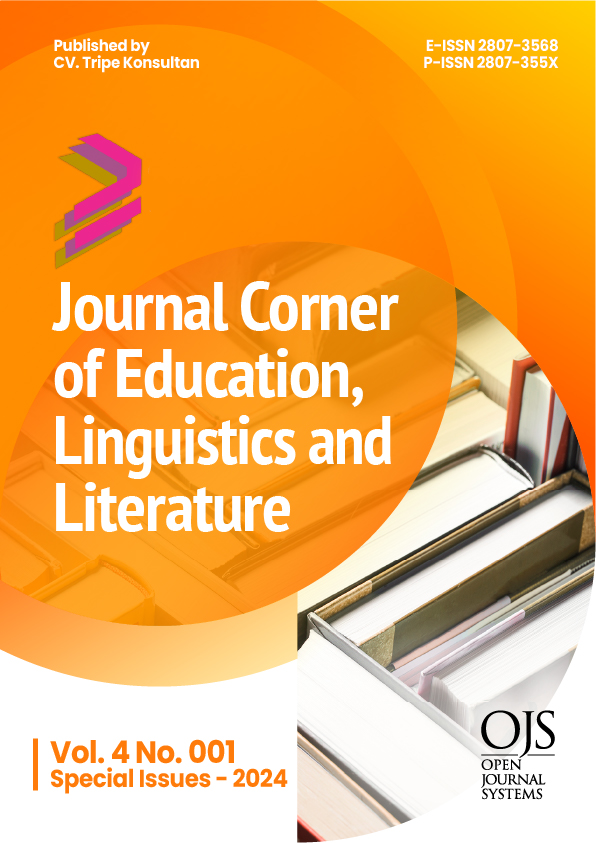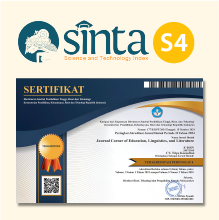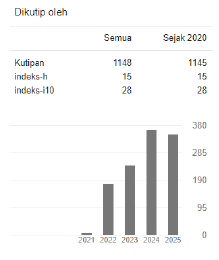Code Switching and Code Mixing in the English Learning Process
 https://doi.org/10.54012/jcell.v4i001.506
https://doi.org/10.54012/jcell.v4i001.506
 Abstract views: 86
Abstract views: 86
 PDF downloads: 34
PDF downloads: 34
Keywords:
Sociolinguistics, Code Switching, Code Mixing, English Language AcquisitionAbstract
This research seeks to explore the function of language during the process of studying English within the classroom setting. The phenomenon of language in question is the occurrence of code switching and code mixing in classroom education. This kind of research is qualitative and descriptive. Data were collected from assertions that include code switching and code mixing during the English learning experience in the classroom. The intended conversation appears as a dialogue consisting of words, phrases, clauses, and sentences that showcase elements of code switching and code mixing, along with the functions of code switching and code mixing. The source of data was derived from dialogues occurring between students and teachers in the classroom. The method employed for gathering data involved recording techniques. The analytical method for data was applied to all speech indicating the use of code switching and code mixing in conversations between teachers and students within the classroom, specifically by condensing data, presenting data, and making inferences. According to the results of the research, different forms of Code Switching and Code Mixing occur in the process of learning English, which the researcher has detailed in the discussion.
Downloads
References
Ahmad, Saleh. (2024). Crossing the Boundaries of Languages: Code-Switching and Code-Mixing Tendencies in the Young Generation in Bangladesh. Canadian Journal of Language and Literature Studies. (10-31). https://doi.org/10.53103/cjlls.v4i2.152
Albahoth, Zakria M. (2024). A Systematic Review of the Literature on Code-Switching and a Discussion on Future Directions. International Journal of Academic Research in Business and Social Sciences. (61-80). DOI:10.6007/IJARBSS/v14-i2/20452
Aslinda, dan Syafyahya, Leni. (2014). Pengantar Sosiolinguistik. Bandung: Reflika Aditama.
Ayu, Desmi. (2025). A Sociolinguistic Analysis of Code Mixing Usage Among Generation Z at Muhammadiyah University of Tangerang. Variable Research Journal. (154-168).
https://variablejournal.my.id/index.php/VRJ/article/view/174
Chaer, Abdul and Leony Agustina Leonie. (2010). Sosiolinguistik, Perkenalan awal. Jakarta: Rineka cipta.
Cook, V. (2013). Second Language Learning and Language Teaching. Melbourne: Edward Arnold/ Hodder Headline Group.
Crystal, D. (2019). The Cambridge Encyclopedia of Language. Cambridge University Press: Cambridge.
Hawkins, John. A. (2023). Bilingualism-induced language change: what can change, when, and why?. Linguistica e Filologia (Brill). (1-17). https://doi.org/10.1515/lingvan-2023-0089
Holmes, J. (2013). An Introduction to Sociolinguistics. London: Longman.
Hudson, R.A. (2008). Sociolinguistics. Melbourne Sydney: Cambridge University Press.
Kumar, D. (2023). An Introduction to Language Contact With Sociolinguistics and Causes the Language Changes Over Time . Asia Pacific Journal of Religions and Cultures, 7(2), 228–240. retrieved from https://so06.tci-thaijo.org/index.php/ajrc/article/view/263216
Kridalaksana, Harimurti. (2023). Kamus Linguistik. Jakarta: Gramedia pustaka.
Miles, Matthew B. and Huberman, A. Michael. (2020). Qualtative Data Analysis. London: Sage Publications.
Moleong, Lexy J. (2021). Metode Penelitian Kualitatif. Bandung: Remaja Rosda Karya.
Nababan. (2007). Sosiolinguistik Suatu Pengantar. Jakarta: PT. Gramedia Jakarta.
Nursjam. (2004). Indonesian-English Code Mixing in Tourism Context. Hasanuddin University.
Saleh, Muhammad dan Mahmudah. (2017). Sosiolinguistik. Makassar: Badan Penerbit UNM.
Sumarsono. (2017). Sosiolinguistik. Yogyakarta: Pustaka Pelajar.
Tarigan. (2024). Code Switching and Mixing Among Students at Catholic University of Saint Thomas. Journal of Linguistics, Culture & Communication. (243-264).
DOI: https://doi.org/10.61320/jolcc.v2i2.243-264
Trudgill, P. (2000). Sociolinguistics. London: Penguin.
Downloads
Published
How to Cite
Issue
Section
License
Copyright (c) 2024 Ani Latifah

This work is licensed under a Creative Commons Attribution-ShareAlike 4.0 International License.
All articles published in the Journal Corner of Education, Linguistics, and Literature are licensed under the Creative Commons Attribution-ShareAlike License (CC BY-SA).

















